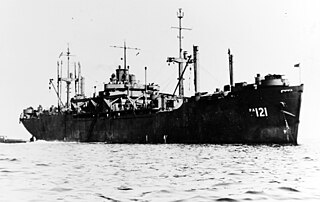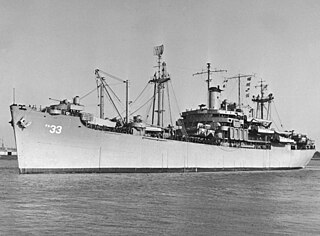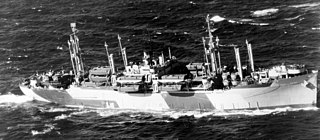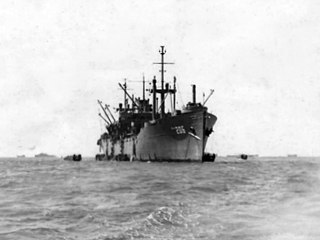
USS Southampton (AKA-66) was a Tolland-class attack cargo ship of the United States Navy, named after Southampton County, Virginia. Southampton was designed to carry military cargo and landing craft, and to use the latter to land weapons, supplies, and Marines on enemy shores during amphibious operations. She served as a commissioned ship for 21 months.

USS Highlands (APA-119) was a Haskell-class attack transport built and used by the US Navy in World War II. She was a Victory ship design, VC2-S-AP5. She was named after Highlands County, Florida, United States.

USS Hendry (APA-118) was a Haskell-class attack transport of the US Navy that was built and served in World War II. She was of the VC2-S-AP5 Victory ship design type. She was named after Hendry County, Florida.

USS Hocking (APA-121) was a Haskell-class attack transport in service with the United States Navy. from 1944 to 1946. She was scrapped in 1974.

USS Mellette (APA-156) was a Haskell-class attack transport in service with the United States Navy from 1944 to 1946 and from 1950 to 1955. She was scrapped in 1988.

USS Barrow (APA-61) was a Gilliam class attack transport serving in the United States Navy from 1944 to 1946. She was scuttled in 1948.

USS Bayfield (APA-33) was a Bayfield-class attack transport built for the United States Navy during World War II, the lead ship in her class. Named for Bayfield County, Wisconsin, she was the only U.S. Naval vessel to bear the name.

USS Dionne (DE-261) was an Evarts-class destroyer escort of the United States Navy during World War II. She was sent off into the Pacific Ocean to protect convoys and other ships from Japanese submarines and fighter aircraft. She performed escort and antisubmarine operations in dangerous battle areas and returned home with six battle stars, a high number for a ship of her type.

USS Lander (APA/LPA-178) was a Haskell-class attack transport in service with the United States Navy from 1944 to 1946. She was sold for scrapping in 1983.

USS Harry Lee (APA-10) was a Harry Lee-class attack transport that saw service with the US Navy during World War II. She served in the Pacific War, as well as in North Atlantic Ocean operations, and safely returned home post-war with seven battle stars to her credit. She was the only ship in her class.

USS Feland (APA-11) was a Doyen-class attack transport which served with the US Navy during World War II. She saw service in the Pacific War, and safely returned home post-war with five battle stars to her credit.

USS Beckham (APA-133) was a Haskell-class attack transport in service with the United States Navy from 1944 to 1946. She was scrapped in 1974.

USS Lowndes (APA/LPA-154) was a Haskell-class attack transport in service with the United States Navy from 1944 to 1946. She was scrapped in 1983.

USS Lauderdale (APA-179/LPA-179) was a Haskell-class attack transport acquired by the U.S. Navy during World War II for the task of transporting troops to and from combat areas.

USS Sandoval (APA-194/LPA-194) was a Haskell-class attack transport in service with the United States Navy from 1944 to 1946, from 1951 to 1955 and from 1961 to 1970. She was scrapped in 1983.

USS Lubbock (APA-197) was a Haskell-class attack transport in service with the United States Navy from 1944 to 1946. She was scrapped in 1975.

USS Fremont (APA-44) was a Bayfield-class attack transport that served with the US Navy during World War II.

USS Knox (APA-46) was a Bayfield-class attack transport in service with the United States Navy from 1944 to 1946. in 1947, she was old into commercial service and was finally scrapped in 1971.

USS Sibley (APA-206) was a Haskell-class attack transport of the US Navy, built and used during World War II. She was of the VC2-S-AP5 Victory ship design type. Sibley was named for Sibley County, Minnesota, which was itself named after Henry H. Sibley, an early pioneer in the territory and first Governor of the state.

USS President Adams (AP-38/APA-19) was a President Jackson-class attack transport of the United States Navy, named for John Adams and John Quincy Adams, the second and sixth Presidents of the United States.




















